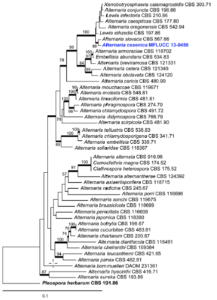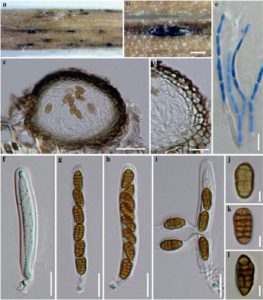Alternaria cesenica Phukhamsakda, Qing Tian, Camporesi & K.D. Hyde.
Index Fungorum number: IF550899, Facesoffungi number: FoF 00408; Fig. 2.
Etymology – The specific epithet Cesenica refers to the place in which the fungus was first collected.
Holotypus – MFLU 14–0795
Saprobic on dead branch of Bellevalia romana (L.) Sweet. Sexual morph Ascomata 100 – 200 μm high, 84 –225 μm diam. (x̄ = 170 × 160 μm, n = 10), on the surface of the host, solitary, scattered, or sometimes gregarious, globose, superficial, black, smooth. Peridium 22 – 33.5 μm (x̄ = 28.5 μm, n = 6), at the outside composed of irregular, thick-walled, brown to black cells of textura angularis, inner layer composed of slightly, smaller cells of textura angularis. Asci 68 – 104 × 11 – 14 μm (x̄ = 85 × 12 μm, n = 10), 6 – 8 – spored, bitunicate, clavate to subellipsoid, short pedicellate, apically rounded, with an ocular chamber. Hamathecium comprising 1 – 2 μm broad, septate, long, branched or simple, pseudoparaphyses. Ascospores 16 – 23 × 8 – 10 μm (x̄ = 19 × 9 μm, n = 10), uniseriate or overlapping uniseriate, ellipsoid to fusiform, muriform, dark brown to blackish-brown, constricted at the center, lower cell narrow and longer, smooth -walled. Asexual morph Undetermined.
Culture characters – Colonies on PDA, reaching 2 cm diam. after 2 weeks at 16 °C, later with dense mycelium, circular, margin rough, white, surface flat, without aerial mycelium. Hyphae septate branched, hyaline, thin.
Material examined – ITALY, Forlì-Cesena Province: Fiumana, Predappio, dead and hanging branches of Bellevalia romana (Asparagaceae), 7 February 2013, E.Camporesi IT1052 (MFLU 14–0795, holotype); ex-type living culture, MFLUCC 13–0450. GenBank ITS: KP711383; LSU: KP711384; SSU: KP711385; TEF: KP711386.
Notes – Alternaria is a genus of pathogenic and saprobic taxa (Woudenberg et al. 2013). The genus was originally introduced by Nees (1816) as Alternaria tenuis, which is currently treated as a synonym of Alternaria alternata (Woudenberg et al. 2013). Comoclathris has been reported as a sexual morph of Alternaria and has muriform, yellowish to dark brown ascospores. Comoclathris clusters within Alternaria in phylogenetic analyses (Woudenberg et al. 2013). Molecular analysis provides evidence that Alternaria cesenica is a new species grouping in section infectoriae (relatively high bootstrap support of 88 % from RAxML and the Bayesian PP of 1.00, Fig. 1). The sexualmorph is rarely found in Alternaria.

Fig. 1 Phylogram generated from parsimony analysis based on LSU, SSU, ITS and TEF1 sequence data of Pleosporaceae. Parsimony bootstrap support values greater than 50 % are indicated above the nodes, and branches with Bayesian posterior probabilities greater than 0.95 are given in bold. The ex-types (reference strains) are in bold; the new isolates are in blue. The tree is rooted with Pleospora herbarum CBS 191.86.

Fig. 2 Alternaria cesenica (holotype) a, b Ascomata on host c Section of ascomata d Peridium e Pseudoparaphyses f Immature ascus. g, h Asci with ascospores i Fissitunicate ascus j – l. Ascospores. Scale bars: b = 500 μm, c = 200 μm, d = 100 μm, e – i = 10 μm, j – l = 5 μm.
